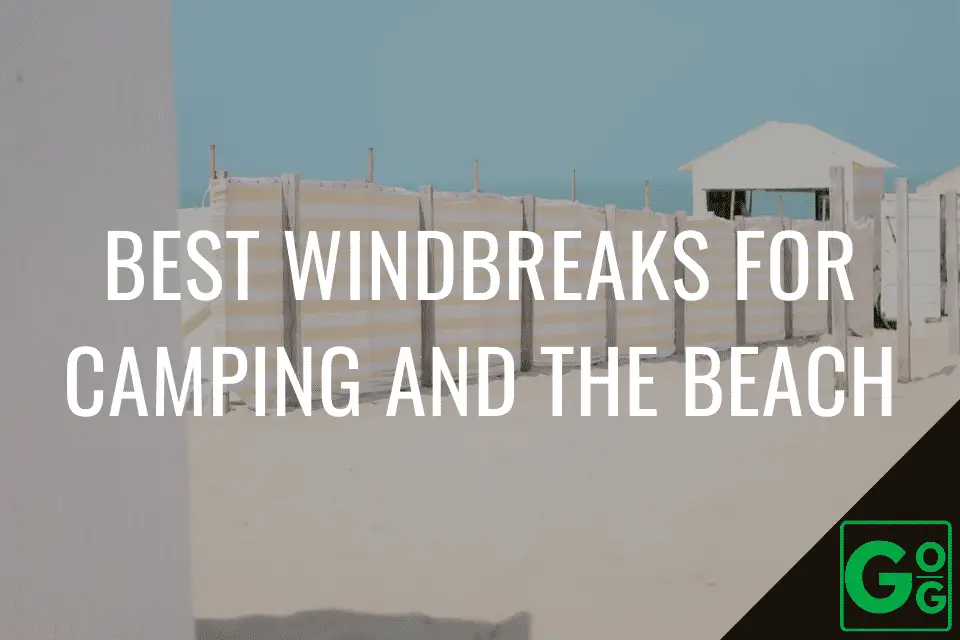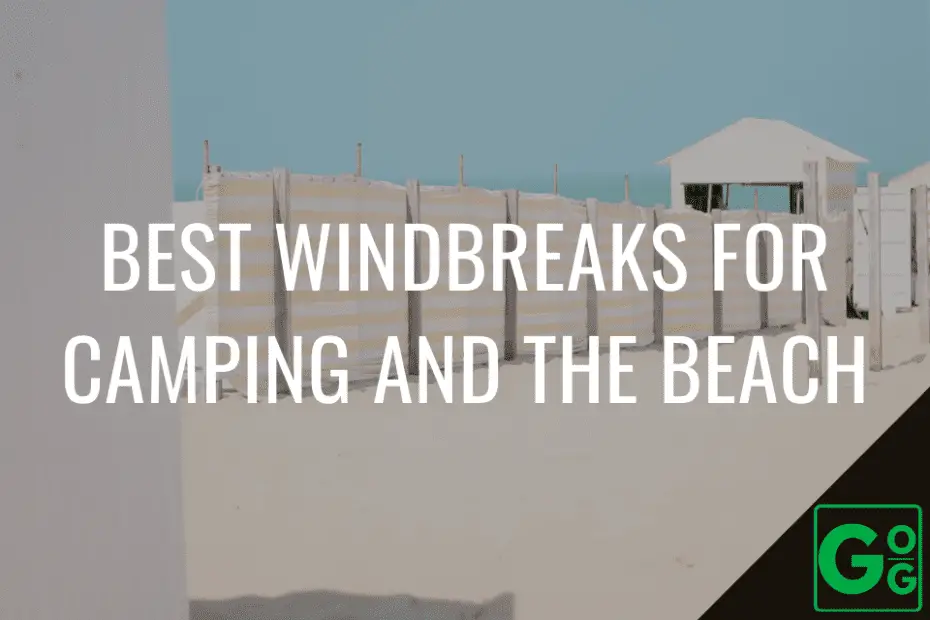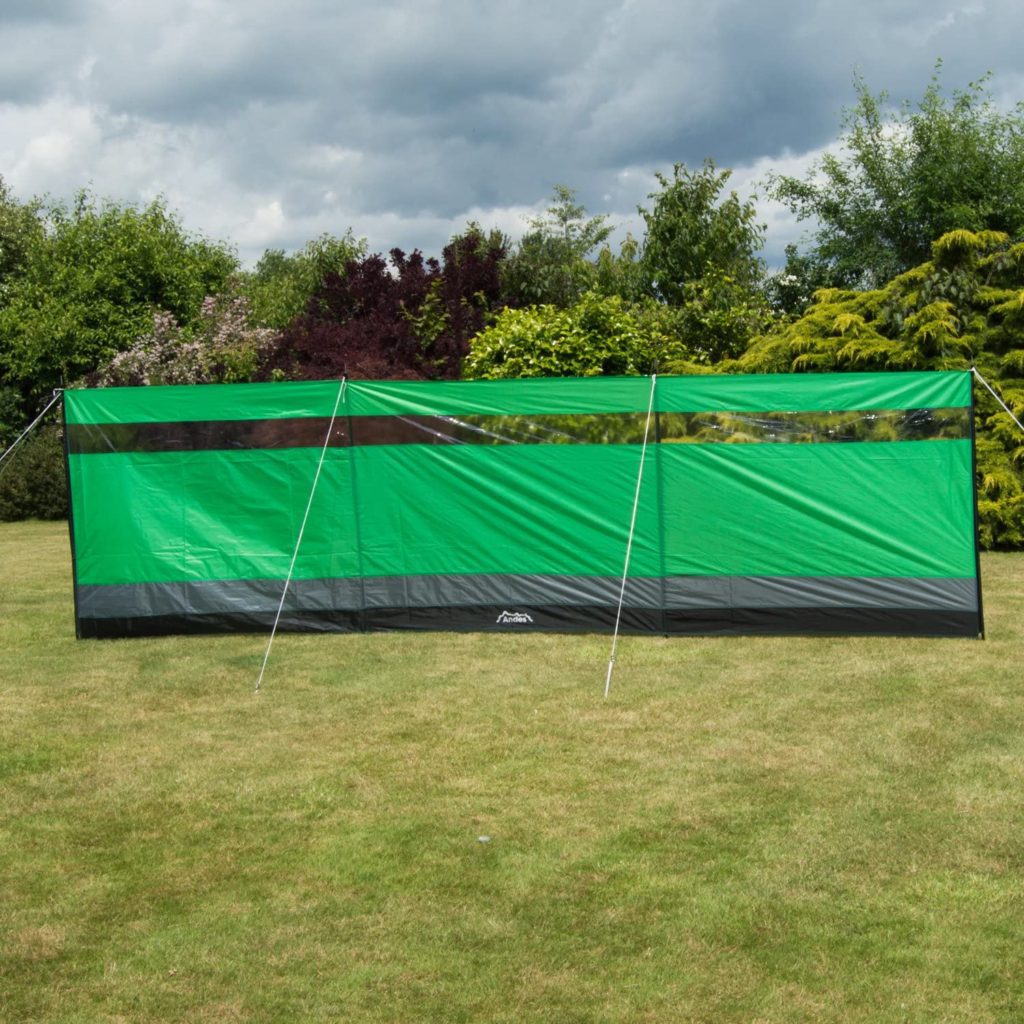We support our blogging by participating in affiliate programs. We may receive a small commission if you click through a link in this post and purchase something you need, however, this will have no impact on the price you pay for the item. Learn more about it on the Disclosure page.
I can’t stand it when I’m sitting down at the beach or around the campsite and suddenly the wind blows sand or dirt in my face. If you can relate then, like me, it’s time you invested in a windbreak.
In the following guide, I will go through some of the best windbreaks on the market today and explain some of the pros and cons of camping windbreaks.

Recommended Windbreaks
Which Windbreak Should I Buy?
Before you invest in a new windbreak, below are some considerations to make. For each of the windbreaks on my list, I will add some details matching these criteria.
What Size Windbreak Do I Need?
Camping windbreaks come in all shapes and sizes, but what is the right size for you? If you are car camping and have a lot of space, then you can go as big as you want. If you are backpacking or camping in a small space, then you need to be more selective in your windbreak size.
The best way to determine the size of windbreak you need is to consider the height and width of the opening that you want to protect. For example, if you are using a tent, then measure the height and width of the door. Add at least 2-3 feet to each side for good coverage. So if your door is 60 inches high and 48 inches wide, then you would need a windbreak that is at least 72 inches high and 96 inches wide.
If you will be using your windbreak for creating a shelter for you at your campsite, simply to provide a bit of privacy and protection from the wind, you can probably go for a standard size windbreak.
If you are trying to create a nice area around your caravan, you can go for a long windbreak as you will likely have more space to pack your windbreak.
What Sort of Fabric for My Windbreak?
The fabric used to make your windbreak will make a big difference in how it behaves and how you will need to treat it.
Polyester windbreaks tend to be lighter, which will make them easier for you to carry. However, they are more likely to flap around than canvas windbreakers.
A canvas windbreaker will flap around less. However, if your canvas windbreak gets wet, it will be heavier to take down and will take longer to dry. It will also be heavier to transport than a polyester windbreak.
How Heavy Is a Windbreak?
How heavy your windbreak is will depend on the size and material.
As a guide, this Candy Stripe Windbreak, which is 3.75m x 1.3m weighs just 2.66kg. This uses aluminium poles to help bring the weight down more.
On the other hand, this Cotton Canvas Windbreak which is 3.2m x 1.1m is 4kg. Given it is smaller, that is a lot of extra weight.
You should note though, that these windbreaks don’t weigh a huge amount overall, but if you are already carrying quite a few accessories with you, this might be somewhere to save some weight.
Do I Need a Windbreak with Guylines?
Guylines (also known as guy ropes) on a windbreak help to add to the sturdiness of the windbreak. If you are using it on a campsite then guylines could be a good choice.
On a beach, guylines are likely to be less effective as they will be harder to peg into the sand. You can just bury the poles further down if necessary.
How Long Will You Be Using Your Windbreak?
By how long you will be using your windbreak, this is more about long term ownership, as opposed to the length of time you will have your windbreak up.
If you are unsure about whether you will need a windbreak in the long term, you might want to opt for a cheaper windbreak to save on a potentially wasted investment. However, if you are certain that you will be using your windbreak for years to come, you should spend more to get the most bang for your buck.
What’s the Difference Between a Beach Windbreak and A Camping Windbreak?
The two main types of windbreak are beach windbreaks and camping windbreaks.
A beach windbreak is traditionally made with wooden poles, ideal for driving into the sand. They also tend not to come with guy ropes as the wooden poles should provide enough stability.
Camping windbreaks are more likely to have metal bottoms to the poles for use on hard ground.
Using tent pegs and guy ropes on these types of windbreaks is common practice as this will add to the stability of the windbreak. This is a practical necessity as you will most likely be using these for longer periods at a time compared to a beach windbreak.
Best Beach Windbreaks
The following windbreaks are ideal for taking to the beach to protect you from the beach wind and the dreaded sand in your eyes!
1. Kingfisher Windbreak
- 2.7m wide x 0.9m high
- 1.5kg
- No guylines
- Material = Polythene
The Kingfisher Windbreak is a simple windbreak that has been designed to be used on the beach to protect you from the wind.
This windbreak comes with 3 panels, stretching out to provide you with 2.7 metres of protection from this wind. Whilst this isn’t a long windbreak, which you could you to surround yourself at the beach, it is certainly a good option to provide protection on 1 to 2 sides.
Made from polythene, this windbreak will not be damaged by seawater and sand, making it a very durable option for those long days on the beach.
This windbreak is also simple to erect. You simply insert the 4 poles into the ground/sand and hammer them in with a mallet. No fiddly guylines to deal with!
2. WBL Standard Stripe
- 2.9m wide x 1.5m high (other sizes available up to 6.1m wide)
- 2.34kg
- No guylines
- Material – Polythene
The second windbreak on my list is the WBL Standard Stripe 5 pole design windbreak.
The poles on this windbreak are made from wood and you simply push them into the ground for stability. You get 4 panels with this windbreak for shading yourself from the wind.
3. OLPRO Beach Huts Windbreak
- 4.8m wide x 1.3m high
- 3.4kg
- No guylines
- Material = Polyester
Third, on my list of the best windbreaks is the OLPRO Beach Huts Windbreak.
This windbreak is made from polyester and comes with 5 wooden poles, meaning you get 4 panels for protection against the wind.
Being made from polyester increases the weight of this windbreaker vs. the first two. I think this is a small compromise for what is a better-looking windbreaker overall.
4. Idena Wind Shield
- 8m wide x 0.8m high
- 1.6kg
- No guylines
- Material = Cotton
The fourth on my list of the best windbreaks is the Idena Wind Shield.
This large windbreak comes with 7 wooden poles, meaning you get 6 panels to work into the arrangement you desire. In spite of its large size, you shouldn’t find this too heavy to carry around as it weighs just 1.6kg (according to the manufacturer).
5. Yello Outdoor Thick Stripe
- 2.2m wide x 1.2m high
- 1.4kg
- No guylines
- Material = Polythene
The fifth windbreak on my list and the last of the beach windbreaks is the Yello Outdoor Thick Stripe windbreak.
This windbreak comes with 5 wooden poles and is made from polythene. You should find this product easy to carry to your resting spot as it weighs just 1.4kg.
Best Camping Windbreaks
The following windbreaks are specifically designed for camping, generally coming with metal spikes for driving into hard ground and guylines for stability.
6. Andes Large Windshield with Top Window
- 5m wide x 1.4m high
- 2kg
- Guylines for support
- Material = Polyester
Sixth on my list of the best windbreaks and the first camping windbreak is the Andes Large Windshield with Top Window.
If you are needing a windbreak for camping, this windbreak comes with guylines, peg and metal poles, making it light and easy for you to erect.
It also comes with a carry bag, making it easier for you to store and transport it.
7. Olpro Orange & Black Windbreaker
- 5m wide x 1.6m high
- 3.1kg
- Guylines for support
- Material = Polyester
Seventh on my list of best windbreaks is the Olpro Orange & Black Windbreaker.
This windbreaker comes with metal poles, which you simply push into the ground by hand (you don’t need to hammer in wooden poles). The guylines and pegs provided can then be used to give your windbreak added support.
8. Vango Family Windbreak
- 4.4m wide x 1.2m high
- 2.5kg
- Guylines for support
- Material = Polyester
Eighth on my list of best windbreaks is the Vango Family Windbreak.
With this being a Vango product, you know that you are getting good quality here.
The steel poles on this design help with the ability of this windbreaker to withstand strong winds. You just need to use the provided guylines to ensure you get maximum stability.
9. Quechua Camping Windbreak
- 4m wide x 1.5m high
- 2.4kg
- Guylines for support
- Material = Polyester
The ninth windbreak on my list is the Quechua Camping Windbreak.
You will find that this windbreak is a little more basic than the previous camping windbreaks, partly due to the reduced number of panels. However, the low price of this camping windbreak makes it one you should consider if you are looking for an entry-level windbreak.
Best Inflatable Windbreaks
These windbreaks don’t use any poles and are all inflatable. Due to the extra strength required and the more durable materials used to make these windbreaks, you will find that you end up paying a premium.
10. Vango Airbeam Modular Windbreak
- 4.9m wide x 1.3m high
- 6.7kg
- Guylines for support
- Material = Sentinel Exclusive Fabric
Tenth on my list of best windbreaks is the Vango Airbeam Modular Windbreak.
The modular design of this windbreak means that you can put up as many sections as you need and you are not tied to having them all together as one windbreak.
With this being Airbeam technology, there are no hard poles with this design as the sides act like air poles. You simply inflate the panels as you need them.
It also comes with an exclusive material, known as Sentinel Exclusive Fabric, which Vango suggest will give you a longer-lasting product.
11. Kampa AIR Break Pro
- 6.2m wide x 1.4m high
- 8.3kg
- Guylines for support
- Material = Polyester
Eleventh on my list of best windbreaks is the Kampa AIR Break Pro.
Similar to the Vango Airbeam, you need to inflate this windbreak in order to use it. This again means you don’t need any poles to erect this windbreak.
12. Outdoor Revolution 3 Section Oxygen Windbreak
- 5m wide x 1.4m high
- 5.6kg
- Guylines for support
- Material = Polyester
The twelfth and final windbreak on my list is the Outdoor Revolution 3 Section Oxygen Windbreak.
Similar to the previous two windbreaks, you simply inflate the panels to put up this windbreak and then use the guylines for extra stability.
Do I Really Need a Windbreak?
If you are only looking for a windbreak to use occasionally, it might be that you can improvise a shelter to protect you from the wind.
Instead of buying a specific windbreak, you can use a tarp shelter along with some poles to fashion a windbreak. Whilst this might not be aesthetically pleasing, it does provide you with more flexibility as tarps can be used for many different types of shelter.
What Is a Natural Windbreak?
If you don’t have a tarp shelter or windbreak, you can use a natural windbreak to protect you at your camping pitch.
A natural windbreak is as simple as using bushes or walls to create a shelter. By positioning your camping position closer to these natural windbreaks, you could negate the need to buy an actual windbreak.
What Are the Disadvantages of Camping Windbreaks?
Camping windbreaks provide a barrier between the camper and the wind. They can be made from a variety of materials, including canvas, plastic, or metal. While they can provide some protection from the wind, camping windbreaks have several disadvantages.
First, they can be difficult to set up and take down. Second, they can be heavy and bulky to transport. Third, they may not be very effective at blocking the wind. Finally, they can be expensive to purchase and maintain.
How Much Wind Can a Tarp Handle?
A tarp is a piece of fabric that is used to cover an object or to provide shelter from the elements. Tarps can be made from a variety of materials, including cloth, plastic, or metal. They are often used to protect equipment from the weather, provide shade, or create a shelter.
How much wind can a tarp handle? This depends on the size and shape of the tarp, as well as the strength of the wind. A small tarp may not be able to withstand strong winds, while a large tarp could easily handle gusts up to 50 mph or more. It is important to choose the right tarp for your needs and to make sure it is properly anchored in place.
How Do You Block the Wind without A Windbreak?
When camping, there are a few essentials that you need in order to make the experience enjoyable. One of those essentials is a windbreak. A windbreak can provide shelter from the wind and can also help to keep you warm. If you don’t have a camping windbreak, there are a few ways that you can block the wind without one.
One way to block the wind is to use a tarp. You can either string up the tarp between two trees or stakes, or you can put it over your tent. Another way to block the wind is by using a piece of furniture such as a couch or chair. If you have an extra blanket, you can also use that to block the wind. The simplest way is to try and position your tent in a way to create a natural windbreak, such as trees, bushes or even buildings.
Summary
So which type of windbreak will you go for.
For a longer-term investment, you may find an inflatable windbreak provides good value for money, as long as you are not put off by the initial outlay.
















